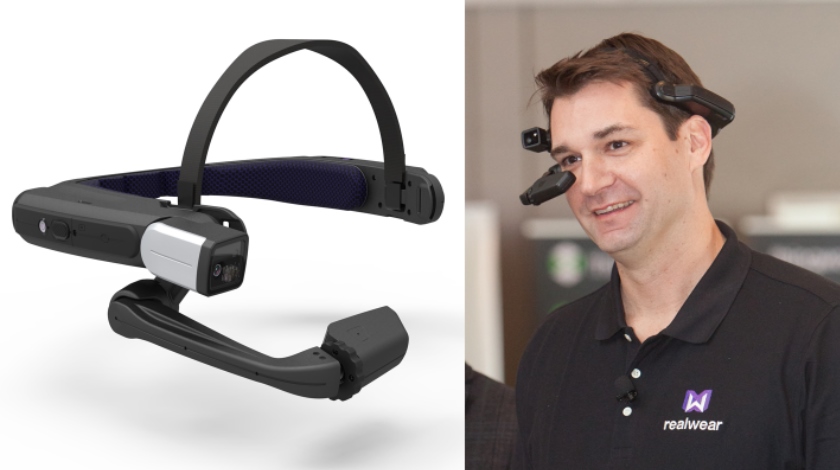Photo: RealWear
Reading Time: 2 minutesBilled as “an industry wearable Boba Fett would’ve loved,” the world’s first voice-controlled, head-mounted wearable is designed to free the hands of technicians and engineers in industrial environments. The RealWear HMT-1 can be worn with a helmet and safety glasses as it delivers computing power and remote collaboration functionality.
RealWear credits part of the design’s inspiration to Boba Fett’s helmet from the Star Wars movies, which—like the HMT-1—has a monocular display for visual data that can be flipped up when not in use. RealWear’s VP of industrial design and human factors, Stephen Pombo, previously worked with one of the original designers of Boba Fett’s prop helmet to create a monocular headset patent at technology company Kopin before going on to develop the HMT-1’s predecessor.
While wearing the HMT-1, workers can use voice commands to browse and search technical documentation or instructions, which are stored on the wearable’s microSD card and can be synced from the cloud using Wi-Fi.
The wearable’s rugged design includes noise cancellation and multiple microphones, which is designed to ensure that field workers can be heard in loud environments while using the wearable’s remote collaboration functionality. This allows experts to watch a procedure taking place via live HD video stream from the wearable’s camera. The remote expert can communicate with the field worker through the audio channel and capture images from the camera, zoom in on details and annotate an image using a pen tablet.
“When a malfunction occurs in an airport distant from the maintainers that have the knowledge to repair it, they are able to dial in to a local maintenance engineer with software like Librestream’s Onsite remote collaboration to diagnose and fix the problem,” says RealWear CEO and Founder Andy Lowery. According to Lowery, the company is working with a major producer of commercial jets to equip each aircraft with an HMT-1 for collaboration functionality like this.
“The most popular applications we integrate and deploy are remote collaboration apps, such as Onsight, workflow applications, such as Frontline, and industrial IoT visualization applications, such as ThingWorx,” says Lowery. Software is installed on the HMT-1 via Wi-Fi or a USB cable connected to a desktop computer, much like it would be with a device like a tablet. RealWear says basic functionality, such as document reading or the recording and playback of training videos, can be done right out of the box.
According to RealWear, benefits of the HMT-1 include increases in productivity and safety, error reduction, and time and cost savings. Lowery says just one use of the HMT-1 will return savings to an airline worth ten times what they would pay for the device. The company has an adaptive pricing model and available leasing programs, but says the cost to buy an HMT-1 and try it out would be $1,500 plus freight.
More than 100 major customers are using the HMT-1 in daily operations, including Boeing, Airbus and American Airlines.

